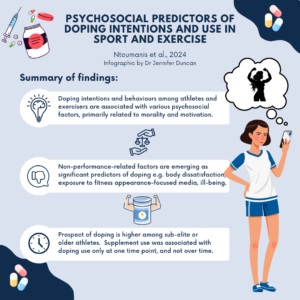Keywords: doping, meta-analysis, protective and risk factors
In this blog we summarise the findings of a recent quantitative review of the literature (i.e., “meta-analysis”) we published in BJSM on psychosocial predictors of doping intention, doping use, and inadvertent doping in sport and exercise settings (1). This project was funded by the Partnership for Clean Competition.
Why is this study important?
The effectiveness of doping prevention efforts could be significantly improved by gaining a deeper understanding of the psychological and social mechanisms that potentially influence doping intentions and behaviour. These mechanisms include risk factors that increase the prospect of doping and protective factors that reduce it. Our study built on a 2014 meta-analysis on a similar topic (2) by incorporating a larger number of studies, new predictors, and more elaborate analytical methods. Additionally, given the growing number of positive anti-doping tests attributed to unintentional use of prohibited substances, we also examined predictors of inadvertent doping.
How did the study go about this?
We included studies that provided quantitative data on doping intentions, doping use, and/or the risk of inadvertent doping, alongside at least one psychosocial predictor of one or more of these doping-related outcomes. We considered both experimental and survey-based studies involving participants from any sport or exercise setting, with no restrictions on demographics. After conducting a systematic literature search, we analysed data from 202 studies with 211 independent samples.
What did the study find?
We analysed experimental and survey studies separately. The experimental studies demonstrated effectiveness in reducing both doping intentions and use, although the effects were modest. For inadvertent doping, the overall effect was larger, but less precise, due to the limited number of studies for this outcome. Survey-based studies (k=186) examined a wide range of psychosocial factors. To make sense of this extensive literature, we ran separate analyses for protective and risk factors. Notable risk factors for doping intentions and doping use included pro-doping social norms and attitudes, supplement use, body dissatisfaction, and general ill-being. Regarding protective factors, self-confidence and morality were noteworthy predictors of lower doping intentions and use.
What are the key take-home points?
Doping intentions and behaviours among athletes and exercisers are associated with various psychosocial factors, primarily related to morality and motivation. Additionally, perhaps due to the rise of social media, non-performance-related factors, such as body dissatisfaction, exposure to fitness appearance-focused media, and overall ill-being, are emerging as significant predictors of doping. Our findings also suggest that the prospect of doping is higher among sub-elite or older athletes, underscoring that, almost achieving elite status or nearing the end of one’s sport career, could potentially be critical phases for doping-related decisions. Interestingly, supplement use was associated with doping use only at one time point and not over time, suggesting a possible co-occurrence between the two rather than supplement use being a gateway to doping. Overall, risk factors have been more extensively studied than protective ones, and the evidence on inadvertent doping remains too limited for definitive conclusions. Given the modest effects observed in experimental studies, we recommend adopting systems-based approaches to anti-doping education and prevention (3). Such approaches involve engaging multiple social agents across different levels, from athletes to sports governing bodies, rather than focusing on a specific group, such as athletes or coaches. Our review contributes valuable insights into the psychosocial mechanisms potentially underpinning doping-related cognition and behaviour in sport and exercise and provides actionable recommendations for improving anti-doping education and research.

Authors: Ntoumanis, Nikos; Barkoukis, Vassilis; Dølven, Sigurd; Boardley, Ian
References:
- Ntoumanis N, Dølven S, Barkoukis V, et al. Psychosocial predictors of doping intentions and use in sport and exercise: a systematic review and meta-analysis. British Journal of Sports Medicine 2024;58:1145-1156.
- Ntoumanis N, Ng JYY, Barkoukis V, et al. Personal and psychosocial predictors of doping use in physical activity settings: A meta-analysis. Sports Medicine 2014; 44:1603–24
- Bates G, Ralphs R, Bond VW, et al. Systems mapping to understand complexity in the association between image and performance enhancing drugs (IPEDs) and harm. International Journal of Drug Policy, 2022; 107:103801.